Camarosporidiella, a challenge
- PMID: 40371417
- PMCID: PMC12070158
- DOI: 10.3114/sim.2025.111.02
Camarosporidiella, a challenge
Abstract
The genus Camarosporidiella is here assessed with respect to its phylogenetic structure and species composition. More than 160 pure cultures from ascospores and conidia of more than 150 fresh collections, mostly from Fabaceae, were prepared as DNA sources. Molecular phylogenetic analyses of a multigene matrix of partial nuSSU-, complete ITS, partial LSU rDNA, and tef1 exon sequences of our isolates and those of previous workers revealed that these markers are insufficient to provide a complete species resolution. From this reduced data matrix, however, we propose synonyms and accept taxa for previously described species, which could not be included in the final phylogenetic tree due to lack of rpb2, tef1 intron and tub2 sequences. The final phylogenetic tree, which was inferred from a combined nuSSU-ITS-LSU-rpb2-tef1-tub2 sequence matrix resolved our isolates into 27 statistically supported phylogenetic species, of which 15 are new. Altogether 34 species are here accepted in Camarosporidiella. Using type studies we stabilise old names, lectotypify Cucurbitaria asparagi, Cucurbitaria caraganae, Cucurbitaria coluteae, Cucurbitaria euonymi, Dichomera elaeagni Hendersonia mori, Sphaeria elongata, Sphaeria laburni Sphaeria spartii and epitypify them as well as Cucurbitaria cytisi, Cucurbitaria retamae and Cucurbitaria steineri to place them in their correct phylogenetic positions and fix their taxonomic concepts. Morphology alone is not suitable to identify these species, and therefore no determinative key to species can be given. However, if hosts are reliably identified, many species can be determined without molecular data. Host images are included with the figures of each fungal species. Taxonomic novelties: New species: Camarosporidiella aceris Jaklitsch & Voglmayr, Camarosporidiella aetnensis Jaklitsch & Voglmayr, Camarosporidiella aragonensis Jaklitsch & Voglmayr, Camarosporidiella asparagicola Jaklitsch & Voglmayr, Camarosporidiella astragalicola Jaklitsch & Voglmayr, Camarosporidiella cretica Jaklitsch & Voglmayr, Camarosporidiella echinosparti Jaklitsch & Voglmayr, Camarosporidiella hesperolaburni Jaklitsch & Voglmayr, Camarosporidiella longipedis Jaklitsch & Voglmayr, Camarosporidiella maroccana Jaklitsch & Voglmayr, Camarosporidiella ononidis Jaklitsch & Voglmayr, Camarosporidiella radiatae Jaklitsch & Voglmayr, Camarosporidiella spartioidis Jaklitsch & Voglmayr, Camarosporidiella sphaerocarpae Jaklitsch & Voglmayr, Camarosporidiella tridentatae Jaklitsch & Voglmayr. New combinations: Camarosporidiella asparagi (Maire) Jaklitsch & Voglmayr, Camarosporidiella caraganae (P. Karst.) Jaklitsch & Voglmayr, Camarosporidiella coluteae (Rabenh.) Jaklitsch & Voglmayr, Camarosporidiella cytisi (Mirza) Jaklitsch & Voglmayr, Camarosporidiella elaeagni (P. Karst.) Jaklitsch & Voglmayr, Camarosporidiella euonymi (Cooke) Jaklitsch & Voglmayr, Camarosporidiella retamae (Pat.) Jaklitsch & Voglmayr, Camarosporidiella steineri (Petr.) Jaklitsch & Voglmayr. New names: Camarosporidiella neomori Jaklitsch & Voglmayr, Camarosporidiella neospartii Jaklitsch & Voglmayr. Citation: Jaklitsch WM, Blanco MN, Rejos FJ, Tello S, Voglmayr H (2025). Camarosporidiella, a challenge. Studies in Mycology 111: 19-100. doi: 10.3114/sim.2025.111.02.
Keywords: Camarosporium; Cucurbitaria; Pleosporales; new taxa; taxonomy.
© 2025 Westerdijk Fungal Biodiversity Institute.
Figures
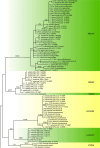




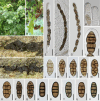





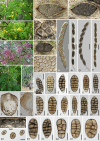













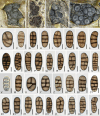
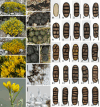













References
-
- Ainouche A, Bayer RJ, Cubas P, Misset MT. (2003). Phylogenetic relationships within tribe Genisteae (Papilionoideae) with special reference to genus Ulex. In: Advances in Legume Systematics part 10, Higher Level Systematics (Klitgaard BB, Bruneau A, eds) Royal Botanic Gardens, Kew: 239–252. https://www.anbg.gov.au/cpbr/publications/bayer-publications/80.Ad.Leg.S...
-
- Barr ME. (1990). Some dictyosporous genera and species of Pleosporales in North America. Memoirs of the New York Botanical Garden 62: 1–92.
-
- Braun U. (2018). Annotated list of taxonomic novelties published in “Herbarium Vivum Mycologicum” issued by J. F. Klotzsch and G. L. Rabenhorst between 1832 and 1855. Schlechtendalia 34: 3–90. 10.25673/90163 - DOI
-
- Carbone I, Kohn LM. (1999). A method for designing primer sets for speciation studies in filamentous ascomycetes. Mycologia 91: 553–556. 10.1080/00275514.1999.12061051 - DOI
LinkOut - more resources
Full Text Sources
